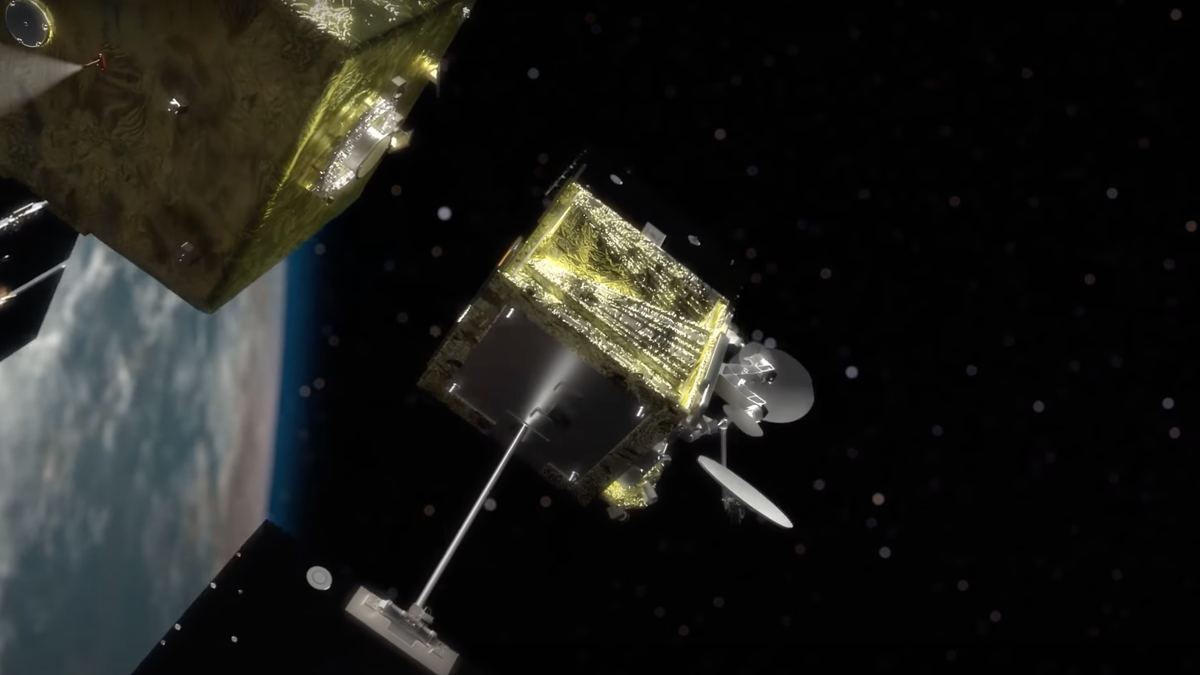Plenty of news stories have focused on the danger posed by Kessler syndrome. In this condition, space is made inaccessible by a cloud of debris surrounding our planet that would destroy any further attempts to get into orbit. Therefore, plenty of companies have sprung up that problem to take care of the problem, from blasting derelict satellites with lasers to helping to refuel them; lots of business models have been created to capture this opportunity. One of the farthest along is Astroscale. This British start-up is tackling the problem with one of the more conventional techniques – linking up with an existing satellite to deorbit it. And recently, they released a promotional video for their new project – the ELSA-M.
ELSA-M, which stands for End of Life Services by Astroscale – Multiple, is designed to couple with an existing satellite, force it into a lower orbit, and reenter more quickly. It will be the first satellite to boost itself up to another orbit for a second rendevous and deorbit that second satellite as well. It’s unclear how many of these projects a single ELSA-M satellite can0 take on, but the “multiple” in its name implies at least more than one.
This mission comes on the heels of a successful demonstration mission known as ELSA-D (or “demonstration”). While that mission was initially planned to prove out four separate tasks for deorbiting, so far, the company has only announced they have completed one. The ELSA-D craft launched with a “client” satellite that was released from the “servicer” satellite and recaptured using proprietary magnetic technology. Most impressively, it released and captured the client repeatedly.
However, the other three steps, including capture with and without tumbling and ” diagnosis ” steps, have yet to have their results announced, though the mission was launched over a year ago. Those very practical problems will also be in play for any commercially viable solution to the problem of space debris, so at some point, Astroscale will have to prove their system can work.
That’s assumedly where ELSA-M comes in. The company’s website describes a servicing satellite with chemical and electric propulsion systems that build on the flight heritage of ELSA-D. Its offerings will include searching for the client satellite, inspecting it, and a safe approach that will allow for a capture.
However, that last bit is only true if the satellite in question happens to have a Docking Plate, as designed by Astroscale themselves. This necessary piece of hardware not only contains the pneumatics and magnetic kit to allow for the actual bonding to take place, but it also contains a QR code that identifies the orientation of the client satellite and conveys some other information to the ELSA-M servicer.
Credit – Astroscale YouTube Channel
Astroscale encourages users to contact them to plan their end-of-life servicing as part of their satellite design. Most responsible satellite providers do understand the danger space debris poses. However, there isn’t a regulatory framework requiring them to abide by Astroscale’s, or anyone else’s, suggested technology requirements to enable safe debris disposal. It’s also unclear when, or even if, such a regulatory framework will be forthcoming. Maybe waiting for Astroscale to prove its technology will be the necessary spur to kick off what will undoubtedly be a necessary feature of space access as it becomes more and more widespread. And maybe ELSA-M will itself be that technology demonstration. For now, only time will tell.
Learn more:
Astroscale – ELSA-M
UT – We Need to Fix Space Junk Before It’s Too Late
UT – There’s a Cloud of Space Debris Around Earth. Here’s how we Could get a Better Picture of it
UT – Companies Will Have Five Years to Dispose of Their Dead Satellites
Lead Image:
Screen capture from the ELSA-M announcement video.C
Credit – Astroscale

